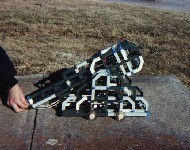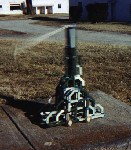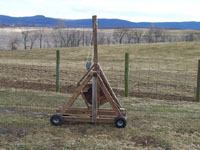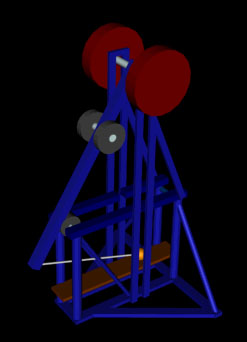Photos
Trébuchets
Potato Guns
Links
A trébuchet is a medieval siege engine which is powered by a falling counterweight. They were mainly used for the siege of castles. They hurled large stones repeatedly at castle walls until the walls came down and the attacking army could enter. They are also known to have been used for an early type of biological warfare: The hurling of diseased corpses, human, horse, or anything else, into castles.
Why do you have a trébuchet?
Short version: because they're cool.
Long version: In college, I somehow got the trébuchet "bug". I looked them up on the Internet, and found tons of sites of people who have built their own "trebs", other sites dedicated to the mathematics of treb operation, sites dedicated to historical reinactment of medieval warfare (and historically accurate trébuchets), etc. etc. For some reason I cannot explain other than to just say, "I'm a guy", I decided I must build one of my own.
I got my friend into my plans to build my own treb, and he built a small machine mostly on his own, but I helped build the sling. It was surprisingly powerful. He shattered a glass marble on the concrete wall of his basement from about 20 feet away. Siege engines are typically given names. We named his machine Imp.


For me, Imp was fun, but I needed more. So I built a bigger, better treb. I found an old ~100 lbs. tractor weight, and started nailing 2x4s around it. Well, not quite like that, I did some calculations first and had a rough idea of what I wanted before I started. What I ended up with, is a fun little machine I call Mjřlnir.

Check this out. Here's a frame-by-frame of Mjřlnir firing. Each frame is about a tenth of a second apart. That's my brother Ronnie pulling the trigger lanyard. Click to see full size.

If you don't know how a trébuchet works, that last picture should help. The front of the machine is on the left. The arm is pulled down and latched by the trigger at the rear. The missile, in this case a rock, is in the sling pouch, which is resting in the trough at the bottom. You can just barely make out the rock in the first frame, just behind the front support. When the trigger is released, the weight drops, pulling the arm up, which pulls the sling, and the missile, rearward (look closely and you can see the rock moving back in the trough). As the arm continues to rise, it pulls the sling up and the missile comes out of the trough, and is whipped around above the arm. In the second to last frame, that blur in the sky is the missile, moving at a fairly high speed. Somewhere between the second to last and the last frame, the design of the sling allows the missile to slip out, and it continues downrange.
If you look closely, you will also notice that the entire machine rolls a little. It is designed to do this. Allowing the frame to roll where it wants will allow the weight to drop more in a straight line, which adds efficiency to the throw. It also helps dampen out any motion left in the arm after the shot.
Here's my design for a big trébuchet, one that can throw pumpkins and bowling balls. I figure 800 - 1000 pounds of counterweight should work nicely.
